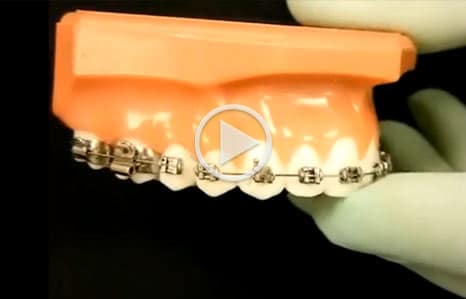Occasionally, some patients will experience an injury to the mouth during treatment. Dental emergencies while wearing braces or other orthodontic appliances generally fall into two categories.
Emergencies Related to Orthodontic Appliances
Sometimes, appliances might be broken or bent during your orthodontic care. If there are any disturbances, such as loose bands, loose brackets, broken or poking wires, please call our office for an appointment during patient hours. After hours feel free to leave a message for us and we will return your call the next business day to schedule you an appointment. For your convenience and the convenience of scheduled patients, it is not possible to handle emergencies on a walk-in basis. In the meantime, here are some helpful hints to remedy some of the problems you may encounter until our office can see you.
- With these tools and supplies you will be prepared to handle the most common orthodontic issues: orthodontic wax, dental floss, disinfected tweezers, a heavy duty nail clipper, Q-tips, pencil with an eraser, salt, tooth picks, OTC pain relievers (acetaminophen or ibuprofen), OTC topical anesthetic (Orabase or Oragel).
- The “O” ring is the tiny rubber band or sometimes a very thin wire (ligature), that holds the orthodontic wire in the bracket/brace. If a rubber o-ring should come off, you may be able to put it back in place using disinfected tweezers. If a wire ligature comes loose, simply remove it with the tweezers. If the wire ligature is sticking out into the lip but is not loose, it may be bent back down with a Q-tip or pencil eraser to eliminate the irritation.
- Some patients are susceptible to mouth sores. While braces do not cause them, they may be precipitated or exacerbated by irritation from the braces. One or several areas of ulceration of the cheeks, lips or tongue may appear. This is not an emergency but may be very uncomfortable. Prompt relief may be achieved by applying a small amount of topical anesthetic (such as Orabase or Ora-Gel) directly to the ulcerated surface using a cotton swab – reapply as needed.
- If a tie wire (ligature) is irritating your mouth, cover it with beeswax or tuck it under the archwire with a blunt object like a pencil eraser or Q-tip.
- Occasionally the end of a wire will work itself out of place or stick out from the back and can irritate the mouth. Use a Q-tip or clean tweezer and try to push the wire so that it is flat against the tooth or if the wire is too long try to push it into a non-irritating position with a Q-tip or pencil eraser. If the wire cannot be moved into a comfortable position, cover it with relief wax and call our office.
- A loose band or bracket can generally be left in place until seen in our office. Call our office during patient hours when you notice a loose band or bracket. We will schedule you to reattach the loose appliance if indicated.
- A broken or poking archwire can often be bent in with a pencil eraser or cut with nail clippers. Before you cut anything however try using the orthodontic wax. Simply pinch off a small piece and roll it into a ball the size of a small pea. Flatten the ball and place it completely over the area of the braces or wire causing irritation. Wax can be purchased at any drug store if you are unable to get some from us during this time. Even if you feel you have resolved the problem, if you have bent of cut something please call our office and make an appointment for us to evaluate the situation and make sure the problem has been resolved properly.
- Watch the video below that explains how to handle common orthodontic emergencies and how to use the comfort wax.
Direct Injuries to the Mouth and Teeth
Following a direct injury to your mouth or teeth, whether undergoing orthodontic care or not, immediately ice the injured area and you should contact your regular dentist as soon as possible. Usually, an x-ray of the involved tooth or teeth is needed to determine the extent of the injury. If a tooth has been displaced, knocked out, or fractured, contact your family dentist as soon as possible as we may not have the necessary materials or anesthesia required to treat these injuries. If you have a tooth that has been knocked out, place the tooth into a liquid and have it re-implanted by your family dentist or an oral surgeon as soon as possible. If your orthodontic appliances are broken, dislodged or displaced as a result of a direct injury, we will need to replace or adjust the appliances as soon as possible, after you have seen your general dentist so please call our office as soon as possible.
After Office Hours
If an orthodontic emergency arises after hours where the patient is in pain that cannot wait until the next business day, please call our office. Information is available on our outgoing message on how to contact our emergency answering service for further assistance.

